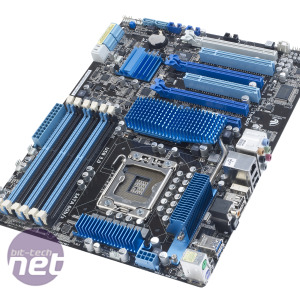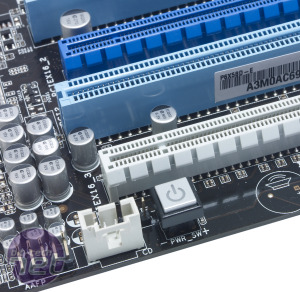
Asus P6X58D-E Review
Manufacturer: AsusUK Price (as reviewed): £149.42 (inc VAT)
US Price (as reviewed): $229.99 (ex tax)
Yesterday we posted our review of the new revision of the Gigabyte GA-X58A-UD3R, a board that has dominated the lucrative lower end of the LGA1366 market for a number of months now. Indeed, the UD3R used to be one the cheapest LGA1366 boards that we had tested, and yet had almost every feature and ounce of performance you could hope for. This has all changed now however, as aggressive price cuts by Asus have now provided the UD3R with some competition in the shape of the identically priced P6X58D-E.
Aesthetically, there’s little to choose between the two boards: both have chunky heatsinks firmly attached to the VRMs, chipset and Southbridge, and both have a clean and attractive layout. Both even share the same white and blue colour scheme, though we think that the black PCB of the Asus D-E board makes the aqua blue of its heatsinks stand out more and look better in a case.
In some areas however, the UD3R (rev 2) offers more than the D-E – it has ten SATA ports (two of which are SATA 6Gbps) while the D-E has only eight (again, two of which are SATA 6Gbps). The rear I/O blocks of both boards are similarly stuffed, with a pair of USB 3 ports each, Gigabit Ethernet, both types of S/PDIF output and FireWire. However, the UD3R (rev 2) has six USB 2 ports at the rear, two of which double as eSATA ports, while the Asus has only four USB 2 ports.
The UD3R (rev 2) also has four 16x PCI-E slots rather than three of the D-E, we have to admit though that there are very few situation where this is likely to be a problem. Asus makes up for this by fitting the D-E with two PCI slots compared with the single slot of the UD3R (rev 2). Again this is unlikely to be a big deal for most people.
One slight potential problem for the D-E is its lack of an IDE port – we imagine you’ve ditched your IDE drives by now, but if not, this is a significant benefit that the UD3R (rev 2) has over the Asus board. On the other hand however, the D-E does have an on-board power switch whereas the UD3R (rev 2) doesn’t. It’s a relatively minor feature, but it can be useful if you’re booting the board on a test bench or problem-finding.
Where the Asus shines is in overclocking-specific features. Three jumpers are scattered around the PCB to unlock extra (higher) voltage options in the BIOS, and the motherboard has the Mem OK! button for checking memory compatibility when POSTing, or applying a memory overclock once your system has booted.
The Asus board also has a solid 16+2 phase power delivery for the CPU, which looks chunkier and more able than the UD3R (rev 2)’s power circuitry. This should theoretically be of benefit when overclocking, though as our testing didn’t find any issues with 12-phase power circuitry of the UD3R (rev 2), this isn’t a concern for air-cooling at least.
Specifications
- Chipset Intel X58
- CPU support LGA1366 Core i7, Core i7 Extreme Edition
- Memory support 6 slots: max 24GB DDR3 (2,200MHz)
- Expansion slots Three 16x PCI-E 2.0 slots (16x and two 8x, or two 16x and one 1x), two PCI, one 1x PCI-E
- Sound Intel HD Audio via Realtek ALC889 with 8-channel support
- Networking Marvel 88E8056 Gigabit Ethernet
- Overclocking CPU Clock 100 – 500MHz; max voltages, CPU 2.1V, PLL 2.5V, QPI/DRAM 1.9V IOH 1.4V, ICH 1.7V, RAM 2.46V
- Ports 6 x SATA 3Gbps, 2 x SATA 6Gbps, 2 x PS/2, 8 x USB 2, 2 x USB 3, 2 x FireWire, LAN, 4 x surround audio out, line in, mic, optical and coxaial S/PDIF out
- Dimensions (mm) 305 x 244 (ATX)

MSI MPG Velox 100R Chassis Review
October 14 2021 | 15:04












Want to comment? Please log in.